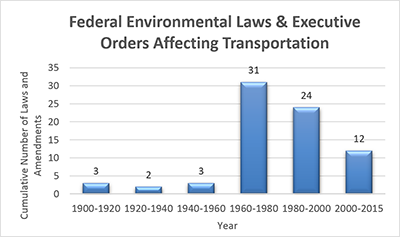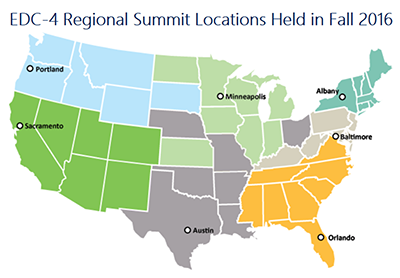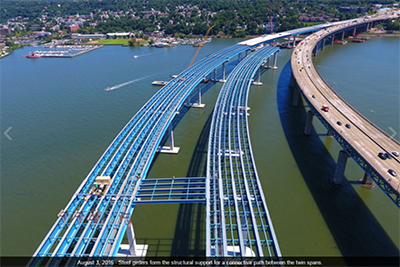
New Integrating
NEPA
and Permitting Approach Provides Opportunities
for States to Accelerate Project Delivery
The Federal Highway Administration (FHWA) strives to help deliver transportation projects on time and on budget. To promote methods for accelerating project delivery, FHWA, in cooperation with the American Association of State Highway and Transportation Officials, launched Every Day Counts (EDC) in 2009. EDC is a State-based model for identifying and deploying proven but underutilized innovations to shorten the project delivery process and improve safety, planning, and environmental outcomes. EDC facilitates regional summits every two years where FHWA gives presentations on these innovations. EDC also provides funding and technical support to help transportation agencies and field practitioners apply the innovations during a two-year development cycle. FHWA has successfully completed four rounds of EDC; the most recent round (EDC-4) was launched in the fall of 2016.
During the EDC-4 summits, FHWA presented the “Integrating National Environmental Policy Act (NEPA) and Permitting” approach to help Federal, State, and local transportation agencies navigate project delays associated with the environmental review and permitting process. Transportation projects require multiple Federal permits and reviews, including reviews under NEPA, to ensure that projects are built in a safe and responsible manner and that adverse impacts to the environment and communities are avoided, minimized, and mitigated. While these permits and reviews reduce adverse impacts from transportation projects, they can pose related challenges such as project delays and increased costs.
The Legislative Landscape
Federal environmental laws and Executive Orders related to transportation have increased from the 1960s to the present. The table to the right illustrates this trend.
While these regulations seek to improve public safety and the environment, they also make completing transportation projects increasingly difficult. Integrating NEPA and Permitting is a strategy for navigating this legislative landscape to efficiently complete projects while reducing impacts on the environment and saving resources.

From the 1960s, environmental laws pertaining to transportation have increased significantly. (Courtesy FHWA)
Fourth Round of Every Day Counts Kicked Off with Regional Summits
During the fall of 2016, transportation agencies from around the country were invited to a series of regional summits across the nation. The summits were hosted in Portland, Sacramento, Minneapolis, Albany, Baltimore, Austin, and Orlando. Each promoted the 11 unique EDC-4 innovations that cover planning, infrastructure, safety, operations, and environment, including Integrating NEPA and Permitting.

The first round of EDC-4 summits were dispersed among seven different geographic regions. (Map courtesy of FHWA)
The regional summits provided transportation professionals with opportunities to learn about innovations, exchange ideas with agency and industry colleagues in neighboring States, and provide feedback to FHWA on the support and resources needed to adopt the innovations in their own States.
Time was allotted during the summits for attendees to provide feedback on each innovation and to identify areas of concern and interest. The most prominent area of concern raised by Integrating NEPA and Permitting attendees was permitting delays caused by a lack of coordination and trust among State DOTs and State and local resource agencies. Attendees also expressed interest in FHWA helping with the following:
- Facilitating discussions with resource agencies;
- Offering targeted technical assistance in the form of workshops and peer exchanges on topics such as the design-build contracting method; and
- Obtaining examples of cooperative agreements and other integration documents.
Integrating NEPA and Permitting Promotes Synchronization Techniques
The Integrating NEPA and Permitting approach provides transportation agencies with a range of integration tools and strategies, such as assistance in developing cooperative agreements with resource agencies that have permitting roles. Integrating NEPA and Permitting builds off two previous EDC innovations: EDC-2 “Programmatic Agreements” and EDC-3 “Improving Collaboration and Quality Environmental Documentation.”
EDC-4 Innovation to Address Challenges that Arise during Permit Reviews
Several challenges can arise during the environmental review and permitting of projects, leading to delays or halting projects altogether. During past rounds of EDC, FHWA received feedback from State and local transportation and resource agencies that these challenges are commonly caused by:
- A lack of early engagement with resource agencies that have permitting roles, responsibilities, or authorities;
- Delayed identification of key environmental and permitting issues;
- Duplicative efforts that use time and resources inefficiently;
- Projects being advanced through NEPA before they are ready to construct; and
- Different levels of understanding and acceptance of innovative contracting methods.
FHWA established the Integrating NEPA and Permitting approach to help State Departments of Transportation (DOTs) and other transportation agencies conduct environmental reviews and permitting procedures concurrently. Historically, these two processes were performed consecutively during the project development cycle with little communication between transportation and resource agencies. Integrating NEPA and Permitting focuses on creating a scalable approach for different NEPA classes of action, establishing a flexible project delivery process, and increasing communication among agencies. It may be most useful to Federal agencies that review permit applications, and to Federal, State, and local agencies that fund or develop major transportation and other infrastructure projects.
FHWA to Offer a Range of Integration Tools and Techniques
FHWA is implementing Integrating NEPA and Permitting with a full suite of outreach and technical assistance to State DOTs and other transportation agencies. Outreach and training efforts target several focus areas, including creating informal and formal agreements, establishing dedicated liaisons, and using FHWA’s online collaboration tool, eNEPA. Specific integration techniques include:
- Promoting process synchronization through the coordination of plans and schedules;
- Developing programmatic approaches, which are documented agreements between agencies and/or organizations that accelerate routine environmental requirements for transportation projects;
- Establishing a dedicated liaison who will serve as a point of contact within resource and regulatory agencies;
- Facilitating early and frequent interagency coordination;
- Utilizing existing communication networks; and
- Revisiting existing integration practices to improve efficiency.
As part of EDC-4, FHWA is also promoting the use of the 2015 Red Book: Synchronizing Environmental Reviews for Transportation and Other Infrastructure Projects. The Red Book, a result of a collaborative effort among six agencies, promotes processes and tools that can benefit multiple agencies and stakeholders. It encourages more widespread adoption of concurrent review processes and supports more effective coordination among transportation, resource, and regulatory agencies during the NEPA and permit review processes. It provides a how-to-guide for synchronizing environmental reviews through proven best practices, data management, and tools for navigating the NEPA review process. FHWA will also develop an online synchronization library that will be accessible to State, Federal, and local transportation agencies in 2017. The synchronization library will provide examples of successful practices, resources, web links, case studies, and contact information to assist State DOTs, Metropolitan Planning Organizations, and local public agencies in integrating NEPA and permitting.
These integration tools and techniques are expected to allow for more effective and efficient regulatory reviews that will result in an environmental analysis and determination that satisfies the needs of all agencies with statutory or regulatory responsibilities in approving Federal-aid highway projects. FHWA expects that the Integrating NEPA and Permitting approach will provide the following benefits:
- Increased Efficiency - Improving the efficiency and effectiveness of the project development, mitigation, and decision-making process;
- Shortened Delivery - Reducing the time and complexity of project development while ensuring projects receive the appropriate coordinated review; and
- Saved Resources - A synchronized review process reducing duplicative efforts, leading to predictability and cost savings.
Tappan Zee Project Exemplifies an Integrated Approach
The Tappan Zee Bridge Replacement project is an example of how Integrating NEPA and Permitting can successfully accelerate project delivery while meeting complex permit requirements. The Tappan Zee Bridge was originally built in 1955, and though it has remained safe for public use since that time, it did not meet efficiency standards for design or traffic operations at the time of the project. The Tappan Zee Bridge experiences high traffic volumes and was selected to undergo accelerated permitting and review because of the vital link it provides to regional and national transportation networks. The project was also included in a White House Presidential Memorandum, which instructed Federal agencies to coordinate permitting and environmental review to expedite the process.

Tappan Zee Bridge under construction (Image courtesy of the New NY Bridge)
The project required numerous approvals prior to design and the start of construction. Due to the large scope and projected timeline, the FHWA New York Division Office, in collaboration with the New York State DOT and resource agencies, including the Army Corps of Engineers and National Marine Fisheries Service, implemented the following strategies to accelerate project delivery:
- Established cooperating agency agreements with each cooperating resource agency;
- Created one point of contact for each cooperating agency and project team that was empowered to make decisions;
- Held “Agency Summits” at which expectations were discussed and priorities were established; and
- Educated contractors on the design-build contracting method during a two-day workshop.
These strategies allowed the New York State DOT to progress from notice of intent to record of decision in 11 months and secure necessary permits in 18 months; this same process can sometimes take several years for large projects. The Tappan Zee Bridge Replacement project demonstrated that strategies for accelerating project delivery save resources, establish stronger relationships through partner coordination, reduce permitting timeframes, and improve accountability for timing decisions and establishing priorities. The success of these strategies exemplifies how useful the EDC-4 Integrating NEPA and Permitting approach can be for completing a large project, but each strategy can also be applied individually to smaller projects or to parts of larger projects.
State Adoption of Integrating NEPA and Permitting to Begin with FHWA Support
Following the regional summits, participating States will caucus and collaborate with their State Transportation Innovation Councils (STIC) to evaluate which innovations to adopt. STICs bring together public and private transportation stakeholders to evaluate and deploy innovations in their state. STICs will assist States in evaluating the innovations, spearheading deployment, and developing the necessary material for the STIC incentive program, which offers Federal funding of up to $100,000 per State.
As a next step, the Integrating NEPA and Permitting team at FHWA will develop an innovation implementation plan and work with individual States on delivering tailored technical assistance to best address their specific challenges.
Contact Information
Michael Ruth, PG
Office of Planning, Project Development & Environmental Review
Federal Highway Administration
Mike.Ruth@dot.gov
(202) 366-9509
Successes in Stewardship is a Federal Highway Administration newsletter highlighting current environmental streamlining and stewardship practices from around the country. Click here to subscribe, or call (617) 494-3719 for more information.

